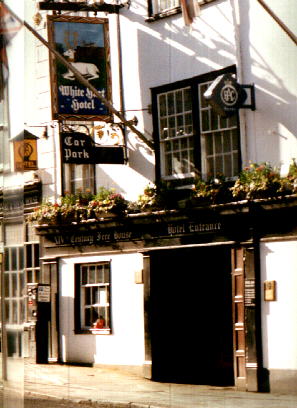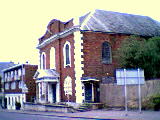
|
| Use the text links for more information! |
| The hog and cigar Across the road by the Market entrance is the The Hogs Head, just one of a growing number in the UK. This place is not a new addition to Fore Street although the decor and continental cafe theme is. The building was constructed after the war in the 1950's as Winstons and incorporated No10's and Churchill's at one time. It is the only cafe bar I've ever been in that serves real ales. Themed pubs are OK as long as they don't destroy tradition or character, such as what taken has taken place at the Ship Inn. This place though is fine. A 50 megaton bomb would not have destroyed the ambience of Winstons. Have a quick pint in here before heading off down South Street. |
|
Speaking of bombs, this part of Exeter together with South Street, and the streets behind the Hog's Head all sustained heavy bomb damage and the lot was levelled. St George's Hall and Market (nearby) were built after the war, the area had previously been a market area; Lower Market. The Chevalier Inn stood just about where the Hogs Head now stands before being flattened in 1942. This was a superb looking building of 'Tudor' design and had previously been known as Chevalier House. It had only been open as a pub for 2 years before being wiped out. |
|
Over the road is British Home Stores. Before the blitz, this was the site of a Gospel Hall, Marypole
Dairy and Marks & Spencer. The small building ajoining the 'Queen Anne' style brick building was the original
temporary premises of BHS after the war, opened in 1951. However this was retained when the store was expanded.
The Queen Anne style brick building at the top of Fore Street was originally Brock's premises and was built in
1884. Cornish's inhabited the building for many years closing their doors in the late 1980's.
On the other corner of North Street stands Posternoster House which was probably built around the turn of the C19th. For years it housed Hepworth's the tailors, later bought by Burtons. South Street
Head out and turn right down South Street. Tozer's Map of 1792 shows South Street split into three names. The upper bit was Cook Row, the steep bit, Bell Hill and the remainder Southgate Street. Cook Row and Bell Hill are also shown on Hogenberg's map of 1587. Kalenderhay
Just a little way down on the left are the ruins of a hall that was known as the Vicars Choral. The hall led to Kalenderhay. The main hall was part of what was a complex of dwellings for priests who at one time were known as the Kalender Bretheren. |
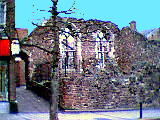 |
A Calender was an officer of the Church whose duty it was to prepare Obits (special masses) in the days when 'Obits' were celebrated on the anniversary of peoples deaths (for an annuity). Kalenderhay will have been where these priests and others lived. Small houses on each side leading to the dining hall. The priest lived apart but ate communally. The Vicars Choral was established in 1388 when the accomodation was built for then by Bishop Brantingham. They were given a Royal charter in 1401 by Henry IV. All that remains is the dining hall that was itself severely damaged during the blitz. The College buildings had been demolished (1850-1900), when the deanery gardens were extended and the Church of St Mary Major Built in 1865. The C16th hall had a very impressive interior and a superb fireplace. On view today is a C14th doorway and two tall windows. In the middle of the ruins is an old Saxon doorway from the Church of St George moved here from the other side of South Street prior to post war re-development. The Church was in fact demolished in 1843, but the doorway was discovered during the re-development. |
| Palace Gate
Where the road reaches its lowest point you'll see Palace Gate on the left.
Head up here. The buildings directly on your left were merchants houses occuppied by Kennaways (a wine merchant). An
original oak carving with the arms of James I displayed the words 'Mansion 1615' and 'Rebuilt 1819'. Kennaway & Co.
started trading in 1743, finally vacating this site in 1975.
|
|
Where the road bends is the Bishop's Palace
Gatehouse. When the Cathedral
was walled in 1286, a wooden gatehouse was constructed close to where the
street lamp now stands to shut off the roadway, there is a marker post
on the northern side of street. This cathedral gate
was removed in 1812. This was
one of the main access ways to Cathedral Close for carriages and carts.
On the opposite side of the street is a relatively new addition (1998) to the pub scene in Exeter. The Firestone was Brazz until May 2006 and is a continental bar and restaurant (upstairs) for pseudo-sophisticates with more money than sense. The building was formerly Mitchel and Son of Exeter Ltd., a builders merchant and wholesale ironmongers (Besley 1947), but had lain dormant for years. 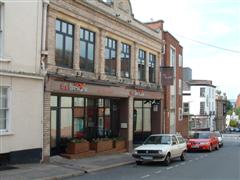 Have a drink of beer in here and head outside. Sir Walter Raliegh's parents lived in a house within Palace Gate in their old age. |
|
Follow the main road around towards the Cathedral. On
the left and part of the Cathedral School is a Victorian building which
retains the name of an earlier building on the site, that of the Chantry,
residence of the Chief Precentor of Exeter Cathedral. It was from this
house that Walter Lechdale
set off to the Cathedral never to return in 1283.
Bear Lane runs from Deanery Place to South Street. Bear Tower once stood on this location until 1965. The Abbots of Tavistock had maintained a pub on the other corner where the Roman Catholic Church now stands. By 1286 the house had become known as Bere. The Bear Inn was an important City Centre meeting place for centuries, even after the dissolution of the monasteries. More information on the Bear Inn is available on the Bygone Pubs pages. Bear street incorporates another site of a Cathedral Gate, the location marked by an iron ring on the street's northern wall. This gate was demolished in 1813. Carry on into South Street and turn left, on your way down South Street notice the Baptist Church and the Roman Catholic Sacred Heart on the corner. |
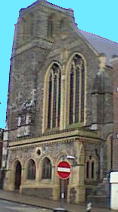
More churches
The first South Street Baptist Church was constructed in 1725 after
the Baptists had gone through a pretty torrid time, much like the Catholics.
The present building was built in 1825. After the blitz
of 1942, only 2 buildings were left standing in South Street, this Baptist church and that
of the Roman Catholic Sacred Heart. Caretakers and ministers of both churches
spent hours throwing burning embers from the roof tops as well as unexploded
incendiary bombs. The Baptist church hall had to be rebuilt after the war
but was sold to Shilhay Community, after the church bought Kennaways Wine
Store alongside the church. The present Palace Gate Centre was created
from these wine premises and was opened in 1979.
The congregation of the Roman Catholic Sacred Heart moved here from
the ruins of St Nicholas Priory
when this church was blessed on 18th November
1884. The church was built on the site of the Bear Inn which was the town
house of the Abbots of Tavistock in the middle ages, as mentioned earlier.
The church roof was replaced in the 1980's.
Carry on down past the lights to the White Heart Hotel on the right.
|
|
|
